Safety Resources - Simulated Error Training for the Physics Plan Review
Project overview:
Simulated error training is a method to practice error detection in situations where the occurrence of error is low. Such is the case for the physics plan review where a physicist may check several plans before encountering a significant problem. By simulating potentially hazardous errors, physicists can become familiar with how they manifest and learn from mistakes that can be made during a simulated plan review. To this end, the AAPM’s Working Group on the Prevention of Errors (WGPE) has developed a series of mock treatment plans/charts that include a variety of embedded errors based on the formal risk-assessment provided by AAPM’s Task Group 275 report. The mock datasets include documentation and DICOM data (images, registration files, RT dose, and RT contours) derived from common treatment planning and radiation oncology information systems. The goal of this project is to provide this data to the AAPM membership in a format that allows them to access it remotely and review it dynamically, thereby providing widespread implementation as a simulated error training module. To this end, the WGPE solicited proposals for a cloud-based solution to host the project. After reviewing several proposals, ProKnow by Elekta was selected as the winner based on its ability to meet the project needs and its inclusion in an educational grant provided by Elekta.
Self-Directed Educational Project (SDEP):
The WGPE has created an SDEP template that can be used in conjunction with this project to claim up to 15 hours of SA-CE and count toward fulfillment of ABR MOC Part 2 requirements. The proposed educational plan is as follows:
- Complete a typical plan review using 5 of the available datasets that share your workplace’s vendor software combination(s), or that most closely resemble your workplace’s vendor software combination(s)
- Compare your documented findings against those provided within the dataset’s “error key”
- For each embedded error that was not detected, determine if this is an unrecognized error that in your workplace has no, or few, other detection methods
- Consider revising the elements of your initial chart and plan review to enable catching these otherwise low-detectability errors
- Review the literature to determine what QA/QC checks can assist in detecting the low-detectability errors, and implement those in a revised chart and plan review process
The template is available for download here.
Registration:
In order to receive access to AAPM’s ProKnow portal, a user must first submit their name and email address below. At the end of each day, this information will be used to register users. Once registered, users will need to visit AAPM’s ProKnow portal through the link below and reset their password by clicking “Click here to set or reset your password”. An email will then be sent to the user’s email with instructions for resetting the password and accessing the site.
 User Registration
User Registration
• First name
• Last name
• Email
• AAPM Member ID
• AAPM members login to access the Registration link.
Site
aapm.proknow.com
Feedback
For questions or suggestions please fill out this form.
This work is supported by an educational grant provided by Elekta. AAPM does not endorse ProKnow nor make any comments as to its utility.
This page is member-only content.
AAPM Administrative Policy 108 states that AAPM members-only content
- shall not be shared in electronic or printed form with non-members*,
- must be linked to through a url provided by AAPM,
- shall not be stored on external drives or servers accessible to non-members.
*See policy for Exception regarding the AAPM Professional Survey
By accessing this page, you agree to comply with AAPM Administrative Policy 108.



















